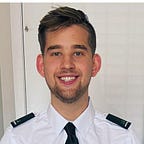Air Traffic Control Entities
In today’s blog post I will be analyzing the relationship between the airport ground controller and the tower controller. Although their jobs are different they both rely on each other to maintain safety and efficiency.
In the United States (U.S) airports are classified into multiple kinds of airspace which offer different services to efficiently keep aircraft moving in a safe manner. For airports classified as class D, C, or B airspace there will be a ground controller along with a controller who manages the initial departures and arrivals. Class D is considered the lowest amount of traffic and only requires a ground and tower controller, but if look at class C airspace there will almost always be an approach controller. Their job is to manage airplanes from the en-route or cruise phase of flight to the approach phase of flight. Class B is used at the largest airports in the country (think of JFK, LAX, ATL). they usually have multiple controller towers that work on individual sides of the airport.
Ground Controllers
The ground controller's job is to get airplanes from their parking position to the departing runway. Also, they could be tasked with issuing IFR route clearance to aircraft as well. However there is sometimes a separate frequency for pilots to contact the ground controller on to pick up this clearance, but it just depends. Ground controllers also have to sequence traffic that has landed and is needing to get to their parking location. This can cause some delays depending on the airport because aircraft needing to get to and from the runway can become congested.
Tower Controllers
Controllers operating the tower are responsible for aircrafts that are departing and arriving at the airport. They’re also responsible for the sequencing of those landing and departing aircrafts. This can become quite difficult if there is a combination of jet traffic and general aviation traffic. This is due to wake turbulence being created by the jet engines, along with how fast each type of aircraft can fly.
How they work together
Both of the controllers will be operating in the same control tower where they can directly communicate with each other on how they want to sequence aircrafts within the airport environment. For example, If there is an aircraft that has a tire blown out on the runway it is critical for both of them to be able to communicate with each other on how they will be dealing with the situation.
References —
Craig Freudenrich. (2020, July 30). How Air Traffic Control Works. https://science.howstuffworks.com/transport/flight/modern/air-traffic-control.htm
Word count: 415
